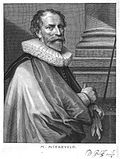Maurice, Prince of Orange, Date of Birth, Place of Birth, Date of Death
TweetMaurice, Prince of Orange
sovereign Prince of Orange from 1618
 Date of Birth: 14-Nov-1567
Date of Birth: 14-Nov-1567
 Place of Birth: Dillenburg, Hesse, Germany
Place of Birth: Dillenburg, Hesse, Germany
Date of Death: 23-Apr-1625
Profession: politician, military officer
Zodiac Sign: Scorpio 
About Maurice, Prince of Orange
- Maurice of Orange (Dutch: Maurits van Oranje; German: Moritz von Oranien; 14 November 1567 – 23 April 1625) was stadtholder of all the provinces of the Dutch Republic except for Friesland from 1585 at earliest until his death in 1625.
- Before he became Prince of Orange upon the death of his eldest half-brother Philip William in 1618, he was known as Maurice of Nassau. Maurice spent his youth in Dillenburg in Nassau, and studied in Heidelberg and Leiden.
- He succeeded his father William the Silent as stadtholder of Holland and Zeeland in 1585, and became stadtholder of Utrecht, Guelders and Overijssel in 1590, and of Groningen in 1620.
- As Captain-General and Admiral of the Union, Maurice organised the Dutch rebellion against Spain into a coherent, successful revolt and won fame as a military strategist.
- Under his leadership and in cooperation with the Land's Advocate of Holland Johan van Oldenbarnevelt, the Dutch States Army achieved many victories and drove the Spaniards out of the north and east of the Republic.
- Maurice set out to revive and revise the classical doctrines of Vegetius and pioneered the new European forms of armament and drill.
- During the Twelve Years' Truce, a religious dispute broke out in the Republic, and a conflict erupted between Maurice and Van Oldenbarnevelt, which ended with the latter's decapitation.
- After the Truce, Maurice failed to achieve more military victories.
- He died without legitimate children in The Hague in 1625, and was succeeded by his younger half-brother Frederick Henry.
Read more at Wikipedia
See Also
- Famous People's Birthdays on 14 November, Germany
- Famous People's Birthdays in November, Germany
- Famous politician's Birthdays on 14 November, Germany
- Famous politician's Birthdays in November, Germany
- Famous military officer's Birthdays on 14 November, Germany
- Famous military officer's Birthdays in November, Germany


